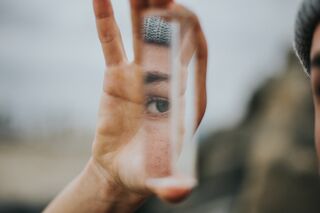Play
How to Enjoy Playing With Your Children
Mirroring can help you reconnect with your kids.
Posted September 28, 2022 Reviewed by Davia Sills
Key points
- Humans unconsciously mirror each other; this phenomenon is called the "chameleon effect."
- Studies have shown that people feel more fondly for those who mirror them than those who don't.
- Mirror neurons are neurons that fire when someone witnesses action in another person, as if they are also embodying that action.

I’ve always considered myself a playful person. Before becoming a parent, my family called me the child whisperer. Being a childless uncle ruled. I would swoop in, do something silly, get a few giggles from the nieces and nephews, and then go home for some peace and quiet.
Life changes when they’re your kids. One game of I Spy fades torturously into 100, and before you know it, you’re dreading the four words that used to set your heart aflame: “Come play with me.”
When I’m played out, I tend to disconnect. I check my email or grab a book to read. After all, you can’t really expect me to play blocks again, can you? I know you’re just going to knock my carefully crafted tower down because that’s what you do! That’s what you always do!
If parents and children play reciprocally, with a sense of give and take (no bossing Daddy around, please), playing offers both parties a unique opportunity to tune in and connect with each other.
Still-Face Experiments
But what happens when we ignore our children’s invitations to play? The famous still-face experiments began in 1975 when Edward Tronick observed mothers interacting with their babies. Midway through their play, the moms would adopt a “still face,” meaning they didn’t respond or interact with their babies. For two minutes, they just sat there with motionless and emotionless expressions.
During the still face part of the experiment, babies tried various tactics to regain their mother’s attention. Then they usually became increasingly upset and despondent. The theory is that the mother’s inattention is mismatched with the babies’ expectations for connection and that without their mother’s engagement, regulating emotions becomes difficult.
From decades of still-face experiments, it seems that babies crave and expect engagement from their primary caregivers. Even two-and-a-half-year-olds demonstrated agitation and despondence when put through the still face experiment. But it’s not practical for us to always stay connected and to play interminably.
Still-face experiments are hard to watch. Babies don’t know what’s happening with their mothers. Why aren’t they smiling and talking to me anymore? The good news is what happens when the two minutes of still-face behavior ends: Reunion and repair. Mothers reconnect and reengage with their babies, much to mother and child’s delight.
For me, this comes down to quality over quantity. I’d rather connect deeply with my children during a brief playtime than phone it in all day. Children know the difference between undivided attention and inauthenticity.
When I’m exhausted or played out, I look to improv comedy to make playing more meaningful and connecting.

Mirroring
The pioneering work of Viola Spolin helps me remember how to get back to basics and reconnect with my children. Spolin’s work began as recreational games used a century ago to help immigrant children socialize and connect. Her work later became associated primarily with improv comedy when her son Paul Sills used her games to found what is still one of the most renowned improv companies in the world, the Second City. But her work started by helping boost children’s social and emotional skills, so it always feels right to me when it gets back to its roots.
Spolin has a set of mirror exercises in her classic improv tome Improvisation for the Theater. Mirror exercises are when two people stand facing each other and pretend to look at their reflection in a mirror. In some variations, one person leads. In others, participants try to move at the same time as their partner, as if no one is leading.
At its core, mirroring is about paying attention to someone else. Spolin calls the objective of each of her games its point of concentration or focus, and in mirror exercises, the focus should be on the other person.

The Chameleon Effect
Humans are hardwired to mirror each other. Studies have shown that we unconsciously mirror people’s gestures and expressions. This is known as the chameleon effect. In a set of studies, participants and research actors collaborated to describe photographs. When the research actors rubbed their faces or tapped their feet, participants were more likely to do the same.
In the next part of the experiment, a post-experiment questionnaire revealed that participants liked partners who mirrored them more than those who didn’t. They didn’t know that they were being mirrored, but something about being mimicked led participants to have more positive feelings toward their partners.
More recently, scientists have discovered mirror neurons, a complex neural system that unconsciously mirrors others. When someone watches someone else jumping, motor neurons in the non-jumping person’s brain fire as if they, too, are jumping.
The chameleon effect and the mirror neuron system reveal a deep connection between people. We unconsciously copy each other, even if only in our minds, and this copying strengthens our bonds with others.
Humans are social creatures who want to be seen by others. Mirroring can help us make others feel seen, especially when we consciously decide to do so.
I don’t always feel like playing dolls or super kitties, but on my best days, I mirror to see where the connection takes us. It helps me stop overthinking and start seeing my children as they are.
Mirroring can be as simple as smiling when my child smiles, copying their laugh, or repeating their babble. It’s often a fleeting moment where I check in with my children, observe them closely, and do what they do.
It may not be groundbreaking or earth-shattering, but mirroring is at the core of being human. It helps us focus on each other and connect. It helps grow our bonds and regulate emotions. It helps us look at the people in our family as if they’re a part of us, just like looking in the mirror.
References
Alcee, M. (2022, September 4). The improvisational parent. Psychology Today. Retrieved September 28, 2022, from https://www.psychologytoday.com/us/blog/live-life-creatively/202209/the…
Chartrand, T. L., & Bargh, J. A. (1999). The chameleon effect: the perception–behavior link and social interaction. Journal of personality and social psychology; 76(6), 893.
Drinko, C. (2013). Theatrical improvisation, consciousness, and cognition. Springer.
Gray, P. (2014, September 6). Playing with children: Should you, and if so, how? Psychology Today. Retrieved September 27, 2022, from https://www.psychologytoday.com/us/blog/freedom-learn/201409/playing-ch…
Rizzolatti, G., Fabbri-Destro, M., & Cattaneo, L. (2009). Mirror neurons and their clinical relevance. Nature clinical practice neurology, 5(1), 24-34.
Spolin, V. (1999). Improvisation for the theater: A handbook of teaching and directing techniques. Northwestern University Press.
Tronick, E. Z., & Gianino, A. (1986). Interactive mismatch and repair: Challenges to the coping infant. Zero to three.
Weinberg, M. K., Beeghly, M., & Olson, K. L. (2008). A still-face paradigm for young children: 2½ year-olds’ reactions to maternal unavailability during the still-face. The journal of developmental processes, 3(1), 4.




